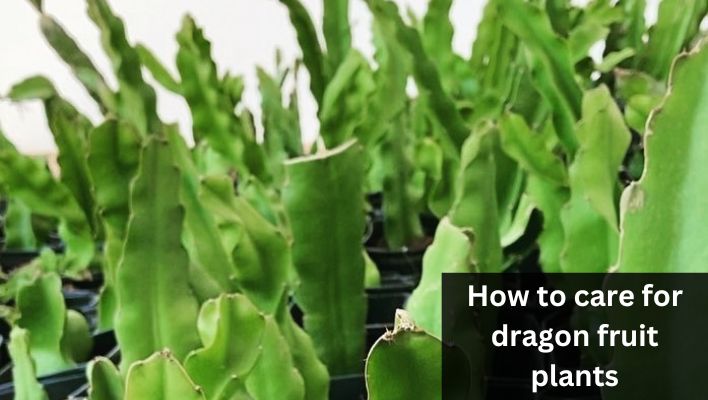Dragon fruit, also known as pitaya, is a tropical fruit that has become increasingly popular in recent years. This exotic fruit is known for its vibrant pink skin, crunchy texture, and refreshing taste. Dragon fruit is not only delicious but also a great source of nutrition. It’s rich in antioxidants, fiber, and vitamins, making it an excellent addition to any diet.
If you’re a fruit lover and looking for a unique addition to your garden, then growing your dragon fruit plant is a great idea. Not only will you be able to enjoy the delicious fruit, but you’ll also get to witness the beautiful blooms of the dragon fruit plant.
However, to ensure that your dragon fruit plant thrives and produces healthy fruit, it’s important to take good care of it. In this article, we’ll explore the various aspects of caring for a dragon fruit plant, from planting to harvesting. Whether you’re a beginner or an experienced gardener, you’ll find all the information you need to successfully grow and maintain a healthy dragon fruit plant.
How to Plant a Dragon Fruit Plant
Planting a dragon fruit plant is an exciting endeavor that can reward you with a beautiful and productive addition to your garden. Here are the steps to successfully plant a dragon fruit plant:
- Choose a suitable location: Select a sunny spot in your garden or outdoor space. Dragon fruit plants thrive in full sunlight, so ensure they receive at least six to eight hours of direct sunlight daily.
- Prepare the soil: Dragon fruit plants prefer well-draining soil. Amend the soil with organic matter, such as compost or well-rotted manure, to improve drainage and fertility. This will help provide a nutrient-rich environment for the plant’s roots.
- Dig a planting hole: Dig a hole that is slightly wider and deeper than the root ball of the dragon fruit plant. Make sure the hole is large enough to accommodate the roots without bending or crowding them.
- Place the plant in the hole: Gently place the dragon fruit plant in the hole, ensuring that the root ball sits at the same level as the surrounding soil. Avoid burying the stem or exposing the roots.
- Backfill and firm the soil: Backfill the hole with soil, gently firming it around the base of the plant to provide stability. Avoid compacting the soil too much, as this can hinder root growth and drainage.
- Provide support: Dragon fruit plants are climbing plants and require support to grow vertically. Install a trellis, fence, or sturdy stakes near the plant to provide a structure for the vines to cling to as they grow.
- Water thoroughly: After planting, water the dragon fruit plant thoroughly to settle the soil and ensure good root-to-soil contact. Watering deeply but infrequently promotes healthy root development.
- Mulch and protect: Apply a layer of organic mulch around the base of the plant to help retain moisture, suppress weeds, and regulate soil temperature. Take precautions to protect the plant from strong winds and frost, if applicable.
- Monitor and maintain: Regularly check the moisture level of the soil and water the plant as needed. Provide additional water during dry periods, but avoid overwatering, as excessive moisture can lead to root rot.
- Fertilize as necessary: Once the plant is established, you can fertilize it with a balanced fertilizer formulated for cacti or succulents. Follow the manufacturer’s instructions for application rates and frequency.
By following these steps, you can successfully plant a dragon fruit plant and set it on a path to healthy growth. With proper care and attention, your dragon fruit plant will reward you with its stunning appearance and delicious fruits.
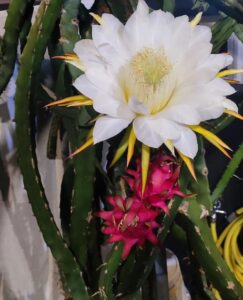
How to Care for a Dragon Fruit Plant
Caring for a dragon fruit plant involves providing it with the right conditions and attention to ensure optimal growth and fruit production. Here are the key aspects of caring for a dragon fruit plant:
Location and Soil Requirements
- Choosing the right location for planting: – Dragon fruit plants thrive in warm, tropical climates and require full sunlight to grow and produce fruit. When selecting a location for planting, choose an area that receives at least 6 hours of sunlight per day and is protected from strong winds.
- Soil requirements and preparation: Dragon fruit plants prefer well-draining soil that is rich in organic matter. Before planting, prepare the soil by digging a hole that is at least twice as wide as the root ball and filling it with a mixture of compost and well-draining soil.
- Benefits of using well-draining soil: Using well-draining soil is essential for growing healthy dragon fruit plants because it helps prevent root rot and fungal infections. In addition, well-draining soil allows for better absorption of nutrients and water, which can promote strong growth and fruit production.
Watering Requirements and Techniques
- Watering frequency and amount: Dragon fruit plants require regular watering, especially during the first few months after planting. The amount of water required will depend on factors such as temperature, humidity, and soil type. As a general rule, dragon fruit plants should be watered deeply once a week, with more frequent watering during periods of high heat or drought.
- Proper watering techniques to avoid overwatering or underwatering: Overwatering or underwatering can be detrimental to the health of your dragon fruit plant. To avoid these problems, water the plant slowly and evenly, allowing the soil to absorb the water before adding more. Avoid watering the leaves or stems, as this can promote the growth of fungal diseases.
- The importance of monitoring soil moisture levels: It’s essential to monitor the soil moisture levels around your dragon fruit plant regularly. Use a moisture meter or stick your finger into the soil to determine if it’s dry or moist. If the soil feels dry to the touch, it’s time to water the plant.
- Watering considerations during different stages of growth: During the early stages of growth, dragon fruit plants require more frequent watering to establish a healthy root system. As the plant matures and begins to produce fruit, you can reduce the frequency of watering, but be sure to provide enough water to support fruit development.
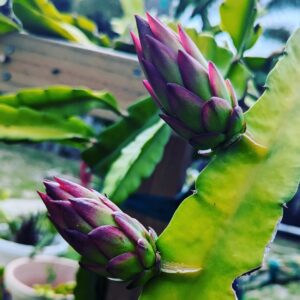
Fertilization Requirements and Schedule
- The role of fertilizer in promoting healthy plant growth: Fertilizer plays a crucial role in promoting healthy plant growth, as it provides essential nutrients that may be lacking in the soil. Dragon fruit plants require regular fertilization to produce healthy foliage and fruit.
- Types of fertilizer recommended for dragon fruit plants: Dragon fruit plants respond well to balanced fertilizers that contain a mix of nitrogen, phosphorus, and potassium. Fertilizers with an NPK ratio of 10-10-10 or 8-4-2 are typically recommended for dragon fruit plants. Additionally, organic fertilizers such as compost and manure can also provide a source of nutrients for your plant.
- Fertilization schedule and application methods: Dragon fruit plants should be fertilized every three months during the growing season (spring and summer). Apply fertilizer to the soil around the plant, avoiding contact with the stem or leaves. Be sure to water the plant thoroughly after fertilization to help distribute the nutrients throughout the soil.
- Organic fertilizer options: Organic fertilizer options for dragon fruit plants include compost, aged manure, fish emulsion, and worm castings. These fertilizers provide a slow-release source of nutrients and can improve soil quality over time.
Pests and Diseases
- Common pests that can affect dragon fruit plants: Dragon fruit plants can be affected by a range of pests including aphids, scale insects, mealybugs, and thrips. These pests can feed on the plant’s sap, causing damage to the foliage and fruit.
- Symptoms of pest infestation and how to prevent them: Signs of pest infestation can include stunted growth, distorted leaves, and discoloration. To prevent pest problems, it’s important to keep your dragon fruit plant healthy by providing adequate water and fertilization. Regularly inspect the plant for signs of pests and remove any affected plant parts immediately.
- Common diseases that can affect dragon fruit plants: Dragon fruit plants can be susceptible to fungal and bacterial diseases such as anthracnose and stem canker. These diseases can cause wilting, yellowing of leaves, and fruit rot.
- How to diagnose and treat plant diseases: If you suspect that your dragon fruit plant is affected by a disease, it’s important to diagnose the problem correctly before applying any treatment. You can consult a local plant expert or take a sample of the affected plant part to a plant disease diagnostic laboratory for analysis. Once the disease is diagnosed, you can apply the appropriate treatment, which may include fungicides or antibiotics.
- Organic pest and disease control options: Organic pest and disease control options for dragon fruit plants include the use of natural predators such as ladybugs, lacewings, and praying mantis to control pest populations. Additionally, neem oil and insecticidal soap can be effective at controlling pests, while copper fungicides can help control fungal diseases.
Pruning and Training
Pruning and training are essential aspects of caring for dragon fruit plants. Proper pruning and training help to maintain the health and shape of the plant, promote fruit production, and prevent overcrowding. Here are some key points to consider when pruning and training your dragon fruit plant:
- Importance of pruning and training: Pruning helps to remove dead, damaged, or diseased stems and promotes the growth of healthy stems. Training helps to manage the growth of the plant and promote fruit production.
- When to prune: The best time to prune dragon fruit plants is during the dormant season, which is typically in winter. This is when the plant is not actively growing, making it less susceptible to damage.
- How to prune: Use clean, sharp pruning shears to cut off any dead, damaged, or diseased stems. Remove any suckers or shoots that are growing from the base of the plant. Prune the remaining stems to maintain the desired shape and size of the plant.
- Techniques for training: Dragon fruit plants are typically trained on trellises to promote fruit production and manage growth. Use soft ties to secure the stems to the trellis, being careful not to damage the stems. Train the stems to grow in a horizontal or angled position to promote fruit production.
- Managing multiple stems: If your dragon fruit plant has multiple stems, it is important to manage their growth to prevent overcrowding. Prune any stems that are growing too close together or in the wrong direction. Train the remaining stems to grow in the desired direction.
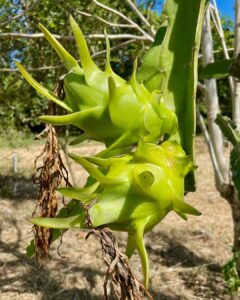
Pollination
- Pollination is an essential process in the growth and development of fruit in dragon fruit plants. Dragon fruit plants can be pollinated naturally by insects, but hand-pollination is often recommended to increase the likelihood of a successful fruit set.
- To hand-pollinate dragon fruit plants, wait until the plant flowers and observe the anthers in the center of the flower. The anthers contain the pollen, which needs to be transferred to the stigma, the female part of the flower. Take a small paintbrush or cotton swab and gently brush the anthers to collect the pollen. Then, transfer the pollen to the stigma of the same or another flower on the plant.
- Factors that can affect pollination success include temperature, humidity, and the number and health of pollinators in the area. In areas with low natural pollinator populations, hand-pollination may be necessary for successful fruit production.
Harvesting and Storing Dragon Fruit
- Harvesting dragon fruit at the right time is crucial to ensure maximum flavor and nutritional value. Most varieties of dragon fruit are ready to harvest 30 to 50 days after flowering when the fruit starts to soften and the skin color turns a bright shade of red or pink. The fruit should be slightly soft to the touch and easily twist off the stem when ready.
- When harvesting, it’s important to handle the fruit carefully to avoid damaging the delicate skin. Use pruning shears or a sharp knife to cut the fruit from the stem, leaving a short stub attached to the fruit. Avoid pulling the fruit off the stem, as this can damage the plant and reduce future yields.
- After harvesting, dragon fruit can be stored at room temperature for a few days or in the refrigerator for up to two weeks. To store the fruit, wrap it in a paper towel and place it in a plastic bag or container. Avoid storing dragon fruit with other fruits that produce ethylene gas, such as bananas and apples, as this can cause the fruit to ripen and spoil more quickly.
Common Problems to Know
Here are some common problems to look out for:
- Fungal infections: Dragon fruit plants can be susceptible to fungal infections such as anthracnose and stem rot, which can cause wilting, discoloration, and decay of the plant tissue.
- Insect pests: Common insect pests that can affect dragon fruit plants include mealybugs, scale insects, and spider mites. These pests can cause damage to the plant by feeding on the sap and leaves, and can also transmit plant diseases.
- Nutrient deficiencies Dragon fruit plants require specific nutrients to grow and produce healthy fruit. Deficiencies in essential nutrients such as nitrogen, phosphorus, and potassium can cause stunted growth, yellowing leaves, and poor fruit quality.
- Overwatering or underwatering: Improper watering can cause root rot, wilting, and other problems. Overwatering can lead to waterlogged soil, while underwatering can cause the plant to wilt and dry out.
- Sunburn: Dragon fruit plants require adequate sunlight, but excessive exposure to direct sunlight can cause sunburn, leading to damage and discoloration of the plant tissue.
- Improper pruning: Incorrect pruning techniques can damage the plant and reduce its fruit production. Pruning too much or at the wrong time can also delay the plant’s growth and development.
- Temperature stress: Dragon fruit plants are sensitive to temperature fluctuations, and exposure to extreme heat or cold can cause damage to the plant. Frost can also be a problem in areas with colder climates.
- Poor soil quality: Soil that is too compacted, lacks nutrients, or has an incorrect pH can cause problems for dragon fruit plants. Poor soil can lead to stunted growth, yellowing leaves, and poor fruit quality.
- Inadequate support – Dragon fruit plants need adequate support to grow and produce fruit. Without proper support, the plant can become damaged or misshapen, and the fruit may not develop properly.
- Lack of pollination: Dragon fruit plants rely on pollination to produce fruit. If there aren’t enough pollinators in the area, or if the flowers are not being pollinated properly, the fruit may not develop or may be misshapen.
- Diseases: Dragon fruit plants can be susceptible to various diseases, including bacterial wilt, root rot, and viral diseases. These diseases can cause wilting, discoloration, and other symptoms, and can be difficult to control once they take hold.
- Environmental stress: Environmental factors such as wind, humidity, and rainfall can also affect dragon fruit plants. Wind can damage the plant or cause fruit to fall prematurely, while high humidity can promote fungal growth and other problems.

How to prevent and treat pest and disease problems
Prevention is always better than treatment when it comes to pest and disease problems with dragon fruit plants. Here are some steps you can take to prevent pest and disease problems from occurring:
- Use clean planting material: Start with clean, disease-free planting material. If you’re growing from seeds, make sure they’re from a reputable source. If you’re using cuttings, make sure they’re taken from healthy plants.
- Practice good sanitation: – Remove any dead or diseased plant material, and keep the area around the plant clean. This can help prevent the spread of disease and eliminate hiding places for pests.
- Monitor your plants regularly: Check your plants regularly for signs of pest or disease problems. Early detection can make it easier to control the problem.
- Control insect pests: Use insecticidal soap, neem oil, or other organic insecticides to control insect pests. Avoid using chemical pesticides, as these can harm beneficial insects and other wildlife.
- Provide proper cultural conditions: Provide your plants with adequate water, nutrients, and sunlight to keep them healthy and strong. This can help prevent stress and make them less susceptible to pests and diseases.
- Trellising: Trellising your dragon fruit plant can help support its growth and make harvesting easier. Use a sturdy trellis or support system to keep the plant upright and prevent it from bending or breaking under the weight of the fruit.
- Fertilizing: Fertilize your dragon fruit plant regularly with a balanced fertilizer to promote healthy growth and fruit production. Avoid over-fertilizing, which can lead to excessive vegetative growth and reduced fruit production.
- Winter care: If you live in a cooler climate, you may need to take special care of your dragon fruit plant in the winter. Protect the plant from frost and cold temperatures by covering it with a blanket or other protective material, and reduce watering to prevent root rot.

How to treat your plants for pests and Diseases
If you do encounter pest or disease problems, there are several treatment options available, depending on the specific problem. For example:
- Fungal infections: Use a fungicide to treat fungal infections, and remove any infected plant material.
- Insect pests: Use insecticidal soap, neem oil, or other organic insecticides to control insect pests. You may also need to remove heavily infested plant material.
- Nutrient deficiencies: Correct nutrient deficiencies by fertilizing your plants with a balanced fertilizer.
- Overwatering or underwatering: Adjust your watering schedule to avoid overwatering or underwatering, depending on the specific problem.
- Sunburn: Provide your plants with shade or move them to a less exposed location to prevent sunburn.
- Use biological controls: Biological controls, such as predatory insects and parasitic wasps, can be an effective way to control pests naturally. These controls can help reduce the need for chemical pesticides and are less harmful to the environment.
- Practice crop rotation: Rotating your crops can help prevent the buildup of soil-borne pests and diseases, such as nematodes and fusarium wilt.
- Use companion planting: Certain plants, such as marigolds, can help repel pests and attract beneficial insects, which can help control pest populations.
- Quarantine new plants: If you’re bringing in new plants, quarantine them for some time before introducing them to your garden. This can help prevent the spread of pests and diseases to your plants.
- Seek professional help: If you’re unsure about how to treat a pest or disease problem, or if the problem is severe, seek professional help. A local gardening center or extension office can provide advice and guidance on how to address the problem.
- Pruning: Prune your dragon fruit plant to promote healthy growth and shape the plant. Prune any dead, damaged, or diseased branches, as well as any branches that are growing in the wrong direction or crossing over each other.
How long it takes for a dragon fruit plant to grow
The time it takes for a dragon fruit plant to grow and reach maturity can vary depending on various factors, including the variety of the plant, growing conditions, and cultivation techniques. On average, it takes about two to three years for a dragon fruit plant to reach full maturity and start producing fruit.
Here is a general timeline of the growth stages of a dragon fruit plant:
- Seedling stage: It usually takes around two to four weeks for dragon fruit seeds to germinate and sprout. During this stage, the plant develops its initial root system and begins to grow small leaves.
- Vegetative growth: After the seedling stage, the dragon fruit plant enters a phase of vegetative growth. This phase can last from several months to over a year, depending on various factors such as climate, care, and growing conditions. During this time, the plant focuses on developing a strong root system, growing thicker stems, and producing more leaves. It is crucial to provide proper support, such as a trellis or stake, to help the plant climb and prevent it from sprawling on the ground.
- Flowering and fruiting: Once the dragon fruit plant has reached maturity, it will start producing flowers. The time it takes for the plant to flower can vary, but it typically occurs when the plant is around one to two years old. The flowers are usually large and showy, opening at night and attracting pollinators such as bats and moths. After successful pollination, the flowers develop into fruit.
- Fruit development: The duration for fruit development can range from 30 to 50 days, depending on the variety and growing conditions. The fruit starts as small, green buds and gradually grows larger. It changes color as it matures, typically turning bright pink or red, depending on the variety. Once the fruit is fully matured, it can be harvested.
It’s worth noting that while dragon fruit plants may start producing fruit after two to three years, their productivity tends to increase with age.
Mature plants can yield a higher quantity of fruit and may have multiple fruiting cycles throughout the year, depending on the climate and growing conditions.
Proper care, including regular watering, fertilization, and adequate sunlight, can help promote healthy growth and fruit production in dragon fruit plants.

How to propagate dragon fruit plants
Propagating dragon fruit plants is an effective way to expand your collection or share these delightful plants with others. There are a few common methods you can use to propagate dragon fruit plants:
Stem cuttings:
This is the most popular method of propagating dragon fruit plants. Here’s how to do it:
- Select a healthy stem from a mature dragon fruit plant. The stem should be about 12 to 18 inches long.
- Using a clean, sharp knife or pruning shears, make a clean cut just below a node (the point where a leaf or branch emerges).
- Allow the cutting to dry for a few days in a shaded area until a callus forms at the cut end. This callus will help prevent rotting when you plant the cutting.
- Fill a pot or container with a well-draining cactus or succulent soil mix.
- Plant the cutting in the soil, burying it partially, with the callused end facing downwards.
- Water the cutting sparingly, allowing the soil to dry out slightly between waterings. Overwatering can lead to rotting.
Seeds:
While growing dragon fruit from seeds is less common, it is still a viable option. Keep in mind that growing from seeds may result in variations compared to the parent plant. Here’s how to propagate dragon fruit from seeds:
- Collect ripe dragon fruit seeds from the flesh of a fully ripened fruit.
- Fill a seed tray or small pots with a well-draining potting mix.
- Sow the seeds on the surface of the soil and lightly press them down.
- Cover the tray or pots with a plastic dome or plastic wrap to create a humid environment.
- Place the tray or pots in a warm location with indirect sunlight.
- Keep the soil consistently moist but not waterlogged.
- Germination usually takes a few weeks. Once the seedlings have developed a few true leaves, they can be transplanted into larger pots.
Grafting:
Grafting dragon fruit involves joining a cutting from a desired variety onto the rootstock of another cactus or related species. This method is commonly used to maintain specific characteristics or to speed up growth. Grafting is more advanced and requires experience and knowledge of grafting techniques.
Regardless of the propagation method you choose, it’s essential to provide the newly propagated plants with proper care, including adequate sunlight, regular watering, and occasional fertilization. Over time, these young plants will grow into mature dragon fruit plants, ready to produce their unique and delicious fruits.
Harvesting and Storing Dragon Fruit
Dragon fruit is typically ready for harvest around 30 to 50 days after flowering. The exact timing may vary depending on the variety and growing conditions. To determine if the fruit is ready, look for the following signs:
- Color: The fruit should have a vibrant color, usually bright pink or red, depending on the variety. The color should be even and uniform.
- Texture: Gently squeeze the fruit. It should have a slight give, similar to a ripe avocado. If it feels too firm, it may not be fully matured.
- Appearance: The scales or spikes on the fruit’s skin should be well-defined and evenly spaced. The skin should be smooth and without blemishes or wrinkles.
Techniques for harvesting dragon fruit:
To harvest dragon fruit, follow these steps:
- Use pruning shears or a sharp knife: Cut the fruit stem about an inch (2.5 cm) above the fruit. Be careful not to damage the fruit or the plant.
- Wear protective gloves: Dragon fruit plants have spines, so it’s advisable to wear gloves to protect your hands while handling the fruit.
- Harvest at the right time: Make sure the fruit is ripe, as described in the previous section. It’s best to harvest in the morning when temperatures are cooler to avoid sunburn or heat stress on the fruit.
- Harvesting clusters: If the dragon fruit is growing in clusters, you can either harvest the entire cluster or selectively pick individual fruits. If you choose to pick individual fruits, make sure they meet the ripeness criteria mentioned earlier.
How to store dragon fruit:
To store dragon fruit properly and extend its shelf life, follow these guidelines:
- Room temperature: Dragon fruit can be stored at room temperature for a few days, especially if it’s already ripe. However, it’s best to consume it as soon as possible for the best taste and texture.
- Refrigeration: If you need to store dragon fruit for a longer period, place it in a perforated plastic bag and store it in the refrigerator. The ideal temperature is around 45-50°F (7-10°C). Properly stored, it can last for up to one week.
- Avoid moisture: Dragon fruit is prone to moisture-related issues. Make sure to keep it dry, as excess moisture can lead to rotting. Avoid washing the fruit until just before consumption.
- Freezing: If you have excess dragon fruit and want to store it for an extended period, you can freeze it. Peel and dice the fruit, then place the pieces in an airtight container or freezer bag. Frozen dragon fruit can last for several months.
Remember that dragon fruit is at its best when consumed fresh. The flavor and texture may deteriorate over time, so it’s recommended to enjoy it soon after harvesting or purchase.
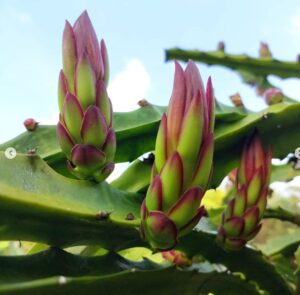
How to care for dragon fruit plants FAQs
When is the best time to harvest dragon fruit?
Dragon fruit is typically harvested when it reaches full maturity. The exact timing may vary depending on the variety and growing conditions, but here are some general guidelines:
- Color: Look for vibrant and even coloration, usually bright pink or red, depending on the variety. The color should be consistent throughout the fruit.
- Texture: Gently squeeze the fruit—it should have a slight give, similar to a ripe avocado. If it feels too firm, it may not be fully matured.
- Appearance: The scales or spikes on the fruit’s skin should be well-defined and evenly spaced. The skin should be smooth, without blemishes or wrinkles.
Harvesting is typically done in the morning when temperatures are cooler to avoid sunburn or heat stress on the fruit.
How long does it take for a dragon fruit plant to bear fruit?
Dragon fruit plants typically take about two to three years to reach maturity and start producing fruit. However, this timeline can vary based on factors such as variety, growing conditions, and cultivation techniques.
Some dragon fruit varieties may bear fruit earlier, while others may take longer. Providing proper care, such as sufficient sunlight, appropriate watering, and regular fertilization, can help promote faster growth and earlier fruiting.
How often should you water a dragon fruit plant?
The watering frequency for dragon fruit plants depends on various factors such as climate, soil conditions, and the stage of plant growth. Here are some general guidelines:
- Establishment phase: For newly planted dragon fruit cuttings or seedlings, water regularly to keep the soil evenly moist but not waterlogged. Aim for deep watering sessions once or twice a week, allowing the top inch of soil to dry out between waterings.
- Vegetative growth phase: Once the plant is established, reduce the frequency of watering. Water deeply once a week or whenever the top few inches of soil have dried out. It’s important not to overwater, as dragon fruit plants are susceptible to root rot.
- Flowering and fruiting phase: During this stage, it’s crucial to maintain adequate soil moisture. Increase the frequency of watering slightly to ensure the plant has enough water for fruit development. Check the soil moisture regularly and adjust the watering schedule accordingly.
It’s essential to consider the specific conditions of your growing environment and adjust the watering frequency as needed. Always monitor the moisture level of the soil and avoid waterlogging or allowing the soil to dry out completely.
What pests and diseases can affect dragon fruit plants?
Dragon fruit plants can be susceptible to various pests and diseases. Some common ones include:
- Pests: Common pests that can affect dragon fruit plants include aphids, mealybugs, scale insects, and fruit flies. Regularly inspect the plants for signs of infestation, such as sticky residues, distorted growth, or visible insects. Use insecticidal soaps, horticultural oils, or organic insecticides to control pests. Beneficial insects like ladybugs and lacewings can also help with pest management.
- Diseases: Dragon fruit plants can be affected by fungal, bacterial, and viral diseases. Some common diseases include anthracnose, stem rot, root rot, and bacterial soft rot. To prevent diseases, ensure proper drainage, avoid overwatering, and maintain good airflow around the plants. If diseases occur, prune and remove affected plant parts and use appropriate fungicides or bactericides as recommended.
Regular monitoring, proper cultural practices, and prompt action at the first signs of pests or diseases can help maintain healthy dragon fruit plants.
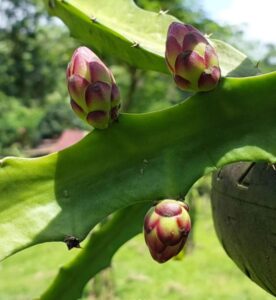
Can dragon fruit plants be grown indoors?
Yes, dragon fruit plants can be grown indoors under suitable conditions. Here are some considerations for indoor dragon fruit cultivation:
- Space and light: Dragon fruit plants require ample space and adequate sunlight to thrive. Choose a location with bright, indirect sunlight or provide artificial grow lights if natural light is limited.
- Container size: Select a large container with good drainage to accommodate the plant’s growth. A 10 to 15-gallon container is generally recommended for a single dragon fruit plant.
- Pollination: Indoor-grown dragon fruit plants may require manual pollination since natural pollinators like bats or moths may not be present indoors. Gently transfer pollen between flowers using a small brush or cotton swab to facilitate a fruit set.
- Climate and temperature: Dragon fruit plants prefer warm temperatures and thrive in tropical or subtropical climates. Maintain temperatures between 65-85°F (18-29°C) during the day and slightly cooler temperatures at night.
- Support structure: Provide a trellis or stake for the plant to climb and support its sprawling growth habit.
Indoor-grown dragon fruit plants require attentive care, including proper watering, fertilization, and regular monitoring for pests and diseases.
Is it necessary to have multiple dragon fruit plants for pollination?
Dragon fruit plants are generally self-pollinating, which means a single plant can produce fruit without the need for cross-pollination with other plants. Each flower of the dragon fruit plant contains both male and female reproductive parts, allowing for self-fertilization.
However, having multiple dragon fruit plants can still be beneficial for several reasons:
- Increased pollination: While dragon fruit plants can self-pollinate, having multiple plants nearby can enhance pollination rates. This can result in more abundant fruit sets and potentially higher yields.
- Genetic diversity: Cross-pollination between different dragon fruit plants can introduce genetic diversity, which can lead to stronger and more resilient offspring. This genetic variation can be beneficial in terms of disease resistance, adaptability to different growing conditions, and potential improvements in fruit quality.
- Extended flowering and fruiting period: With multiple plants, there is a higher chance of staggered flowering times, which can extend the overall fruiting period. This can provide a more extended harvest window and a continuous supply of fresh dragon fruit.
- Insurance against plant loss: If one plant encounters issues such as disease, pests, or unfavorable growing conditions, having additional plants ensures a backup and increases the chances of obtaining a harvest.
While it’s not strictly necessary to have multiple dragon fruit plants for pollination, incorporating multiple plants in your garden or growing area can offer advantages in terms of pollination success, genetic diversity, and overall productivity.
Conclusion
Growing and caring for dragon fruit plants can be a rewarding and enjoyable experience. With the right knowledge and techniques, you can successfully cultivate these exotic and nutritious fruits in your home garden or indoor space.
Proper care for dragon fruit plants involves providing them with well-draining soil, ample sunlight, and consistent watering and fertilization. It’s important to pay attention to the unique needs of dragon fruit plants, such as their susceptibility to overwatering and the importance of providing support for their climbing stems.
In addition, dragon fruit plants may face challenges from pests and diseases such as root rot, mealybugs, and fungal infections. Regular monitoring and preventative measures can help address these issues before they become more severe.
To encourage fruit production, it’s important to ensure that your dragon fruit plants receive enough sunlight, proper nutrition, and adequate pollination. While dragon fruit plants are generally self-pollinating, having multiple plants nearby can enhance pollination rates and improve overall productivity.
With the right care, you can enjoy a bountiful harvest of delicious and nutritious dragon fruit, and create a beautiful and vibrant addition to your garden or indoor space.
